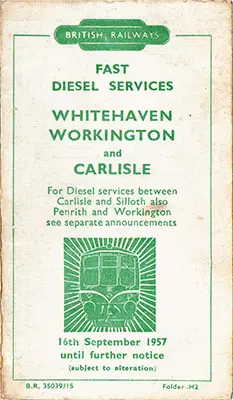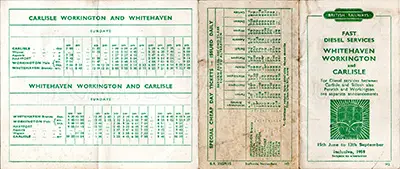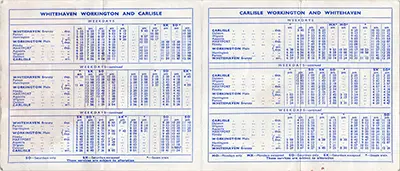DMU Operations: London Midland Region
Workington - Whitehaven - Carlisle

This was the third and final part of the West Cumberland Diesel Scheme, the green line on the route map, introduced on the 7th February 1955. Vehicles required window bars for working over the former M&CR (Maryport & Carlisle Railway) which had restricted clearances.
Initially Derby Lightweights were used, allocated to Carlisle and Workington, they were replaced in 1969 by Class 108s allocated to Carlisle then Newcastle. They were replaced by Second Generation units in November 1991.
February 1955 timetable
On weekdays there had been ten steam services in the previous timetable (from Carlisle at 5.40am, 6.50am, 8.25am, 11.07am, 1.25pm, 4.20pm, 5.06pm, 6.15pm, 7.50pm and 9.05pm). With the diesels the 5.40am and 6.50am departures remained — most likely to fit in with factory starting times etc. — the rest were replaced by an even interval service at 25 minutes past the hour from 8.25am till 4.25pm, and then at 5.15pm, 6.15pm, 7.50pm, 8.30pm and 9.25pm. This increased the services from ten to sixteen. On Saturdays there had been additional trains at 1.00pm and 9.10pm, and the 1.25pm was replaced by a 1.50pm departure.

The services stopped at Dalston, Wigton, Aspatria, Bullgill, Maryport, Flimby, Workington, Harrington and Parton. Timings for the 27¾ miles to Maryport was 42 minutes (previously 47-50 minutes), the 33¼ miles to Workington in 54 minutes (previously 62-65 minutes), and the 40 miles to Whitehaven in 74 minutes (previously 86-92 minutes). All the services kept these timings except the 5.40am, 6.50am and 9.25pm which were given extra time for handling parcels, although most of this work was done by two steam hauled parcels trains.
From Whitehaven services were hourly from 6.55am to 2.55pm and then at 4.15pm, 5.15pm, 6.15pm, 6.45pm, 7.55pm and 9.55pm. Journey times were the same in this direction. The turnaround times at both ends was 16 minutes, allowing a set to do up to five return journeys a day — a total of 400 miles.
Overall, the timings were little improved over previous steam schedules, particularly as the steam schedules had been decelerated in the year or two prior. The 7.55am from Whitehaven managed to knock 15 minutes of the schedule of the previous 7.48am steam train, although it only knocked 13 mins of the previous summer's schedule. The 5.15pm from Whitehaven now took one minute longer, and three minutes longer than the previous summer's. In the up direction accelerations ranged up to 15 minutes, although the 5.40am from Carlisle took only the minute less, and the 7.50am two minutes.
It was mentioned that standing times at stations seemed to be excessive, and that the schedules could be cut once experience had been gained in operating the sets. The diesels made it necessary to introduce a service of steam-hauled parcels trains between Carlisle and Whitehaven, and the two trains were run daily in each direction comprised mainly of LNER six-wheeled parcels vans.
The Sunday service was a vast improvement, with nine services instead of the original two at 6.45am and 4.00pm from Carlisle and 11.00am and 6.30pm return. The DMU times were well spaced out, and as Dalston, Bullgill, Flimby, Harrington and Parton were all closed on a Sunday, the journey only took 66-67 minutes.
This third stage of the West Cumberland Diesel Scheme was thought to have particularly good prospects, as the stations at Carlisle, Maryport, Workington, Whitehaven and Aspatria were all fairly centrally situated in the towns, allowing them to compete better with road transport.
Success
Between the start of the Carlisle and Whitehaven service in February 1955 and the end of April 1955, 91,600 passengers were carried compared to 59,000 in the corresponding period in 1954.
1959 Sample Diagram
A typical 1959 summer diagram (no. 352) involved a Carlisle set starting with the 5.45am to Whitehaven coupled to the Cravens parcel car, which it remained with for the return journey. On its own the power/trailer then made another three trips to Whitehaven before returning around 6.20pm. The 8.25am weekday service to Whitehaven was operated by a 6-car set, and 4-cars were use on other services during the day.
To Barrow
By 1965 some services were extended through to Barrow.
Class 108s
In March 1969 Class 108s were transferred to Carlisle to replace the Derby Lightweights. They would remain as the main traction for the route until replacement by second generation units in November 1991.
Sample Timetables
If you have any timetables that could be added here please get in touch.
Images

12th September 1956
A six-car (three two-cars) Derby Lightweight formation with M79607 closest in Workington station on a rainy 12 September 1956. The top marker lamp is lit and Whitehaven is on the destination blind. Stuart Mackay Collection.

12th September 1956
A six-car (three two-cars) Derby Lightweight formation at Workington station on a rainy September 12th, 1956. The top marker lamp is lit and Whitehaven is on the destination blind. Stuart Mackay Collection.
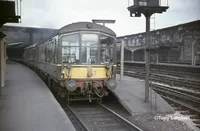
24th April 1965
A Derby Lightweight DMU departs from Carlisle Citadel station with a Whitehaven service on 24 April 1965. Tony Lambert.

20th June 1968
A mixed-livery Derby Lighweight DMU approaches Harrington with the 1.45pm Whitehaven - Carlisle on June 20, 1968. Michael Mensing.

25th June 1968
Lots of activity in Whitehaven station on June 25th, 1968, during a work to rule; including three Derby Lightweight sets. Michael Mensing.

25th June 1968
A blue-liveried Derby Lightweight DMU led by M79180 departs from Aspatria station with a Carlisle - Whitehaven service on 25 June 1968. Michael Mensing.

27th July 1968
An original 79xxx Derby Lightweight set at Birkby Drifts Pit, Cumbria on 27/07/1968, with a service heading for Whitehaven. These early DMUs were nearing the end of their operational lives at this time, with the final examples being withdrawn in 1969. In spite of this, many received rail blue livery. Graeme Phillips Collection.

1975
M50955 is the leading car of the 2-car diesel unit forming the 13.25 to Carlisle at Whitehaven sometime in 1975. Tom Burnham.

1976
Class 108 DMU at Workington in 1976. A class 40 locomotive is also visible on the right. Graeme Phillips Collection.

March 1976
BR (Derby) Class 108 2-car Local Passenger dmu Nos.E50964 (Class 108/2) & E56239 (Class 142) in Rail Blue livery with all yellow front ends arriving at Carlisle on a service from Whitehaven and Workington, 03/76. Hugh Llewelyn.

March 1976
The Joint LNWR/CR Carlisle (Citadel) Station, with a BR (Derby) Class 108 2-car dmu Nos. M50964 (108/2) & M56239 (142) of the 1959 batch on a Whitehaven service, 03/76. Hugh Llewelyn.

March 1976
BR (Derby) Class 108 2-car Local Passenger dmu Nos. E56239 + E50964 in Rail Blue livery with all yellow front ends departing Carlisle (Citadel) on a service to Whitehaven and Workington, 03/76. Hugh Llewelyn.

May 1977
A Class 108 seen at Carlisle in May 1977. A fleet of two-car power-trailer Class 108s based at Carlisle Kingmoor depot, were for many years the mainstay of Cumbrian coast services. In overall BR blue livery, a formation is seen arriving from Whitehaven. These DMUs were finally supplanted from these duties late 1991, replaced by Class 153 single Sprinter cars. Graeme Phillips Collection.

15th August 1979
The colliery was situated about mile south of Workington station and was only in production from 1944 until closure in May 1973. The twin headstocks were still standing in 1979, a northbound DMU passing on 15 August. Kevin Lane.

Unknown date
A two-car Class 108 DMU in Carlisle station with a Whitehaven service, sometime in the 1980s. Stuart Mackay Collection.

21st July 1984
A Carlisle Kingmoor based class 108 DMU set complete with window bars for working over the M&CR (Maryport & Carlisle Railway) with its restricted clearances sits in the bay platform at Whitehaven (Bransty) station having arrived with 2P59 the 12.08 from Carlisle on July 21, 1984. In the forground are the disused lines to Whitehaven and Haig Colliery. Adrian Nicholls.
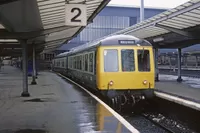
10th July 1987
A Class 108 DMU formed of 53973 + 54263 with a Whitehaven service in Carlisle station on 10 July 1987. Keith Miller.

11th July 1989
Carlisle's celebrity green unit (54247 leading 53964) leaves Carlisle with the 15.40 to Whitehaven on 11/7/89. Leonard Rogers.

26th June 1991
A dirty E53958 and E54227 are seen awaiting departure from Carlisle with a service to Whitehaven on 26/06/91. A fleet of 2-car power-trailer Class 108 DMUs, allocated to Kingmoor (KD) depot, Carlisle, were the mainstay of Cumbrian Coast services for many years. Upon the closure of that depot in May 1988, most were transferred to Heaton (HT) depot, Newcastle, still intended to continue with Cumbrian services (the rest went to Chester (CH) depot for services in north Lancashire). They lasted until November 1991, when finally replaced by then newly-converted Class 153 single car units. Graeme Phillips Collection.
Aylesbury - London
Bangor - Amlwch
Bedford - Bletchley
Bedford - Northampton
Bedford - London
Birmingham - Barnt Green
Birmingham - Derby
Birmingham - Four Oaks
Birmingham - Leamington Spa Ave
Birmingham - Lichfield
Birmingham - Redditch
Birmingham - Rugeley
Blackpool Sth - Kirkham & Wesham
Bury - Bacup
Bury - Rawtenstall
Carlisle - Barrow
Carlisle - Silloth
Carlisle - Skipton
Coventry - Birmingham
Crewe - Derby
Derby - Matlock
High Wycombe - London
Kentish Town - Barking
Leamington Spa - Nuneaton
Leicester - Birmingham
Leicester - Nottingham
Liverpool - Warrington C.
Llandudno - Blaenau Ffestiniog
Machynlleth - Pwllheli
Manchester - Accrington
Manchester - Buxton
Manchester - Chester.
Manchester - Crewe
Manchester - Hayfield
Manchester - Llandudno
Manchester - Macclesfield C.
Manchester - Macclesfield H Rd.
Manchester - Leeds
Manchester - Rochdale
Manchester - Rose Hill Marple
Manchester - Royton
Manchester - Stoke-on-Trent
Nottingham - Derby
Nottingham - Lincoln
Oxenholme - Windermere
Oxford - Cambridge
Penrith - Workington
Preston - Blackpool - Fleetwood
Preston - Colne
Redditch - Four Oaks
Shrewsbury - Aberystwyth
Shrewsbury - Wolverhampton
Stockport - Stalybridge
Watford - St Albans
Whitehaven - Workington - Carlisle
Wrexham - Chester - New Brighton












